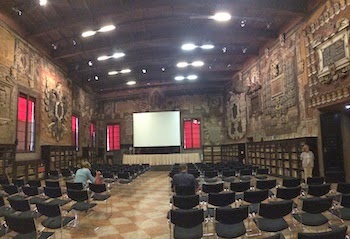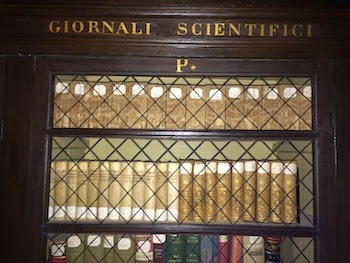 |
| Teatro Anatomica – Anatomy Theatre |
Bologna is a college town, but not like any other college town you’ve visited. There are clusters of the university spread all around the city, and the university has taken over giant churches and converted them to lecture halls. Can you imagine taking a class like freshman English Comp in a former cathedral?
One of the things that makes the University of Bologna fundamentally unique is its age: it was founded in 1088. That’s not a typo, which makes it the oldest university in the world. There are a couple of caveats, the first being that it’s described as the oldest “continuously operating” university in the world, implying (I guess) that there are some reformed and restarted universities that might be older. The other caveat is that its age is compared against the university model of education, which is a concept of the western world. There are almost certainly some Asian schools (of some sort) that are older, perhaps also some western schools, just not universities.
We enjoy touring schools and universities, like the University of Glasgow we blogged about a few weeks ago. The sprawling University of Bologna (85,000 students in 23 different schools) offers a couple of very cool sites for visitors to see. The first is the Teatro Anatomico, the Anatomy Theatre. In this room, cadavers were dissected on the marble slab while medical students watched, took notes, and shot spitballs and made wisecracks to one another (we like to thing college students were the same in the 16th century as they are today). Interesting note: dissections were only conducted during the winter quarter because they lacked ready supplies of Febreze.
On the day we visited the anatomy theatre, included in the price of admission was a visit to a nearby lecture hall that was the site of a debut performance of a chamber piece by Rossini. Or maybe it was Verdi. Still, was your college the site of a debut performance for a baroque masterpiece? I didn’t think so. Today the hall is an operating lecture hall, and students sit surrounded by centuries-old texts of the ways we used to think of our world.
Unfortunately much of what you see in these two rooms is reconstructed: the building sustained a direct hit by allied bombing during World War II. It’s still worth the €4 admission, especially knowing that it was perfectly restored to the original uniquely Bolognese architecture of the rooms, with many of the original fixtures and art returned to their exact locations.
A few notable graduates of the University of Bologna include Popes Innocent IX, Alexander VI, and Gregory XV; Dante Alighieri (of Dante’s “Inferno” fame); astronomer Giovanni Cassini; Guglielmo Marconi, inventor of the modern radio; and modern author Umberto Eco, one of Chuck’s favorite authors.








